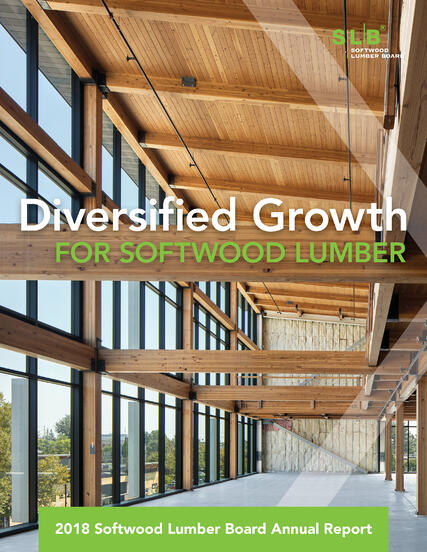HIGHLIGHTS
PROGRAM UPDATES
WoodWorks Hosts Successful “Soft Launch” of Professional Affiliate Program AWC Produces New Tools to Support the 2018 Wood Frame Construction Manual Think Wood Research Library Diffuses Knowledge, Fuels InnovationINDUSTRY NEWS
Nail Laminated Timber Takes Center Stage in New Portland Building Toronto Set to Build First NLT Building Arup Explores Timber’s Global Resurgence New Report Emphasizes Scandinavia’s Innovation in Wood Construction Michigan State University Joins Mass Timber Revolution Everything Old is New AgainINSIGHTS ON THE COMPETITION
Concrete Masonry Checkoff Program Launched to Promote Demand for ConcreteProgram Updates
WoodWorks Hosts Successful “Soft Launch” of Professional Affiliate Program


Timed to coincide with the International Mass Timber Conference, WoodWorks introduced its new Professional Affiliate program at an invitation-only “soft launch” event, attended by developers, architects, engineers, and contractors representing well-known and respected firms across the United States that currently build or are interested in building with wood.
Through the Professional Affiliate program, WoodWorks will serve as a hub by creating opportunities for the architecture, engineering, and construction community to network, providing value-adding services such as training, and helping developers find qualified professionals for their mass timber project teams. The program started in earnest in January 2019 when it launched installer training workshops with the Chicago Regional Council of Carpenters Apprentice & Training Program.
AWC Produces New Tools to Support the 2018 Wood Frame Construction Manual
Softwood lumber is an optimal choice for construction in areas with high wind and seismic activity, thanks to its strength, flexibility, and versatility. The American Wood Council (AWC) is taking steps to ensure that builders and designers have the tools and knowledge needed to specify wood regardless of the challenges created by high winds and earthquakes.
The AWC recently released a new edition of the Wood Frame Construction Manual (WFCM) for One- and Two-Family Dwellings (ANSI/AWC WFCM-2018), which is referenced in the 2018 international building and residential codes, respectively. The WFCM provides designers and code officials with engineered and prescriptive design guidance that results in more resilient wood buildings that can stand up to the high gravity and lateral loads found in extreme wind and seismic events.
The AWC has also rolled out several companion tools that further explore and advise the building community on the WFCM. These include a workbook that shows users how to design a typical two-story residential structure to be wind- and quake-resistant, and a webinar on roof systems and connections that resist wind uplift. To date, nearly 1,000 code officials and designers have accessed the webinar, which is available as part of the AWC’s online eCourse system. Click here to watch a recorded version.
Think Wood Research Library Diffuses Knowledge, Fuels Innovation
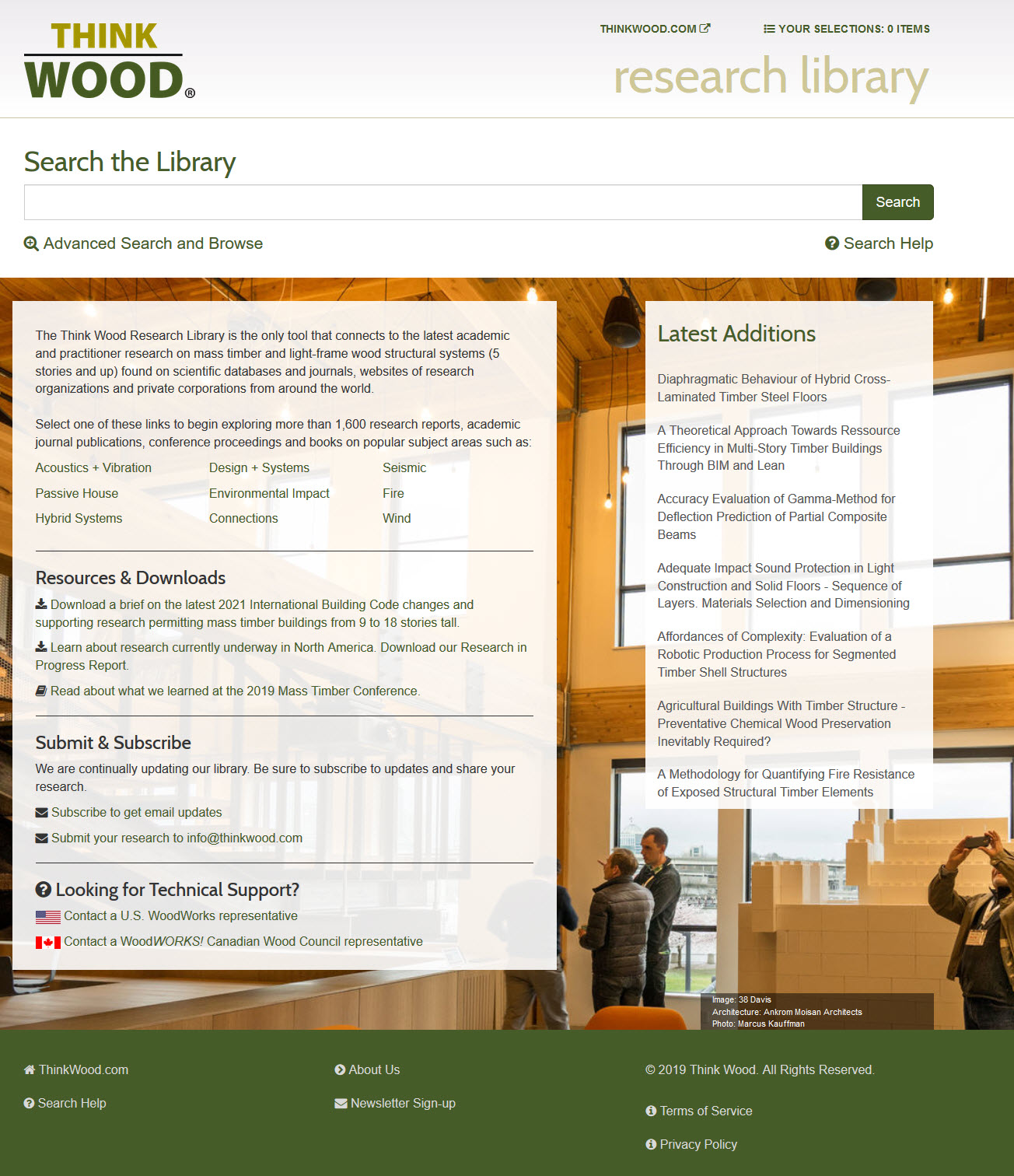
Industry News
Nail Laminated Timber Takes Center Stage in New Portland Building
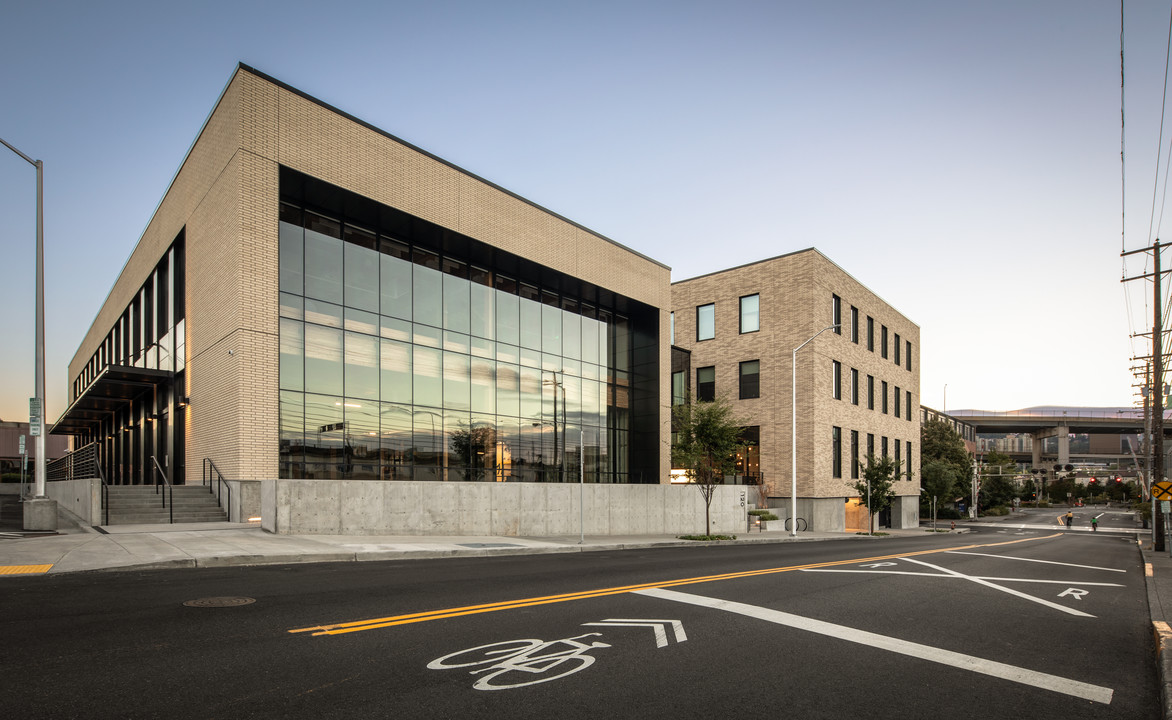
Senior Associate Ben Stinson of Ankrom Moisan Architecture of Portland, Ore., recently reflected on the firm’s development of 120 Clay Pavilion, a three-story, 115,000-square-foot building in Portland’s Central Eastside Industrial District. 120 Clay is a hybrid glulam and steel frame building with a nail laminated timber (NLT) floor system that creates a unifying element between the building’s two wings.
The design team chose NLT as a featured material for both its aesthetics and function. The project’s NLT panels were prefabricated offsite, which reduced overall construction time and offered the team flexibility in accommodating material expansion due to Portland’s generous annual rainfall. According to Stinson, “the texture of NLT lends noticeable aesthetic and acoustic benefits to the space,” and its use helped 120 Clay maximize exposure to natural wood, reduce layout obstructions, and create a more flexible space for tenants.
To read more about 120 Clay and its effective use of NLT, click here.
Toronto Set to Build First NLT Building
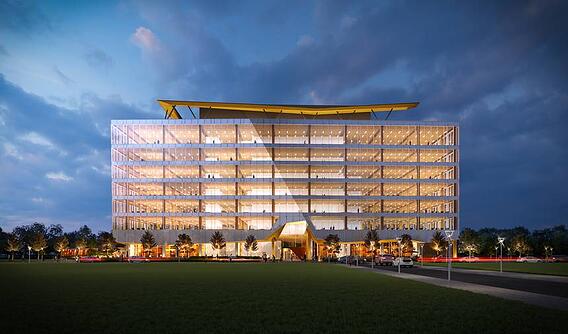
Designed by Bogdan Newman Caranci and engineered by Blackwell Structural Engineers, the eight-story 77 Wade Avenue project in Toronto is on course to become Canada’s tallest commercial building constructed of NLT.
77 Wade will feature hybrid timber-concrete-and-steel construction, engineered specifically to minimize environmental impact. The team opted for exposed NLT ceilings and columns to achieve spans reminiscent of traditional concrete and steel buildings, while enjoying the benefits of NLT’s appearance and savings in time and costs.
Arup Explores Timber’s Global Resurgence
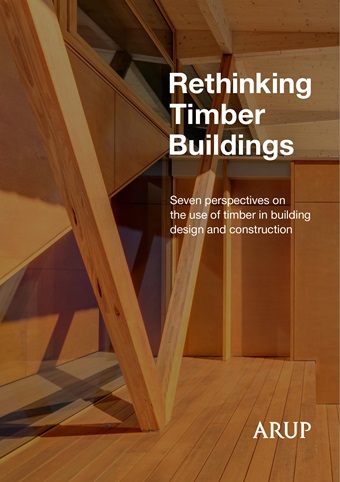
Engineering and design firm Arup recently published the Rethinking Timber Buildings report, which looks at the trends, technologies, and emerging uses that are supporting timber’s resurgence in building design and construction. Using seven different examples and supported by historic precedents and learning from around the world, the report examines the impact of wood use on construction speed, performance quality, building safety, and human experience. The report is sure to be of interest to anyone considering timber construction.
Explore Arup’s report here.
New Report Emphasizes Scandinavia’s Innovation in Wood Construction
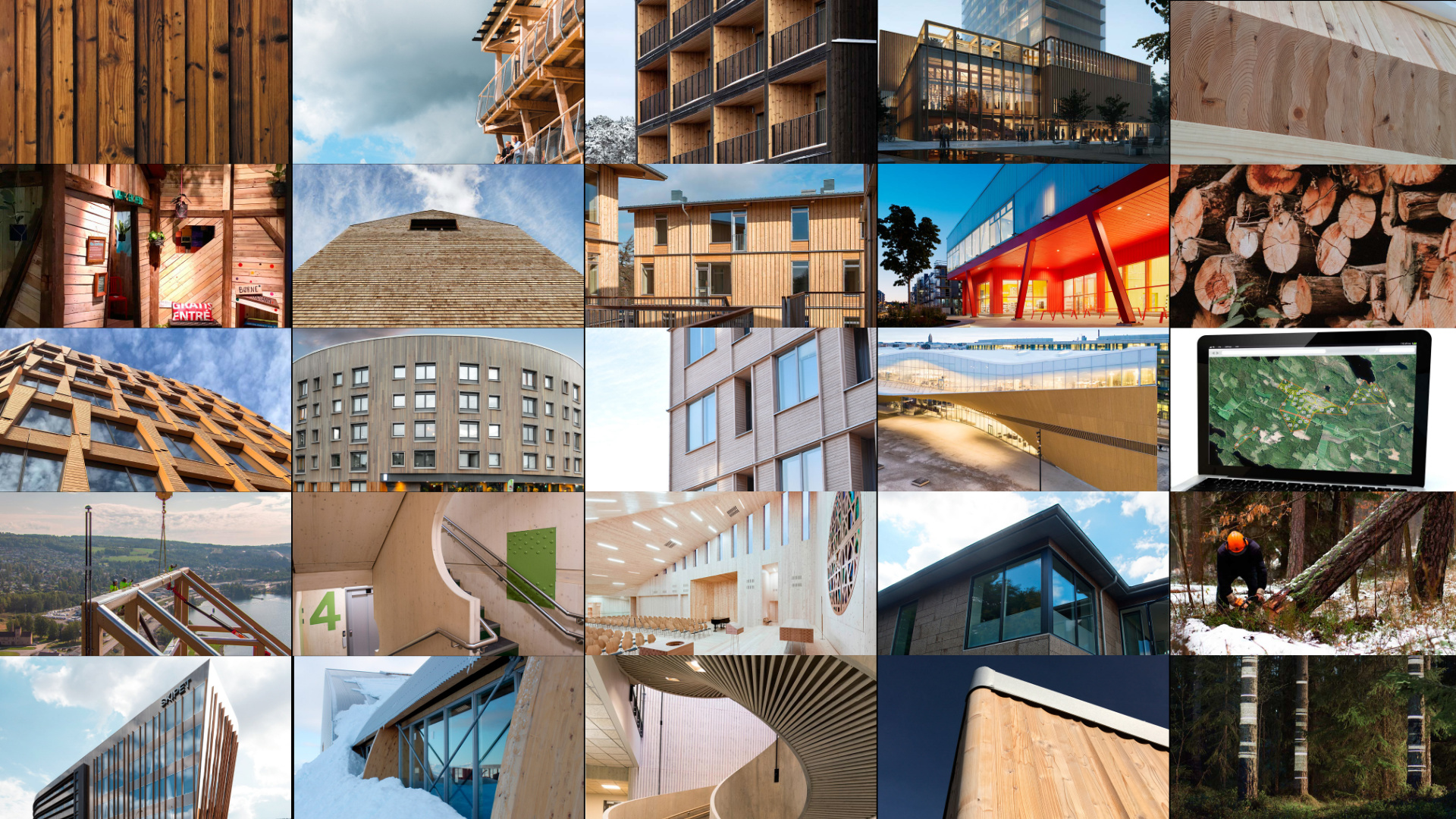
The Nordic Wood in Construction Secretariat has published Wood in Construction: 25 Cases of Nordic Good Practice, a new report highlighting 25 innovative and best practice cases of using wood in construction. The report is the product of an initiative commissioned by the Swedish government and the Nordic Council of Ministers and hosted by EIT Climate-KIC.
The report shows how Nordic countries are sustainably tackling growing urban populations by combining sustainable forest management and wood construction; regularly achieving new milestones in terms of wood building height, size, and innovation; and helping to sustain rural economies.
The report offers valuable learning and perspectives, applicable to projects around the world, on investing in timber construction and creating sustainable alternatives to steel, glass, and concrete in buildings.
Michigan State University Joins Mass Timber Revolution
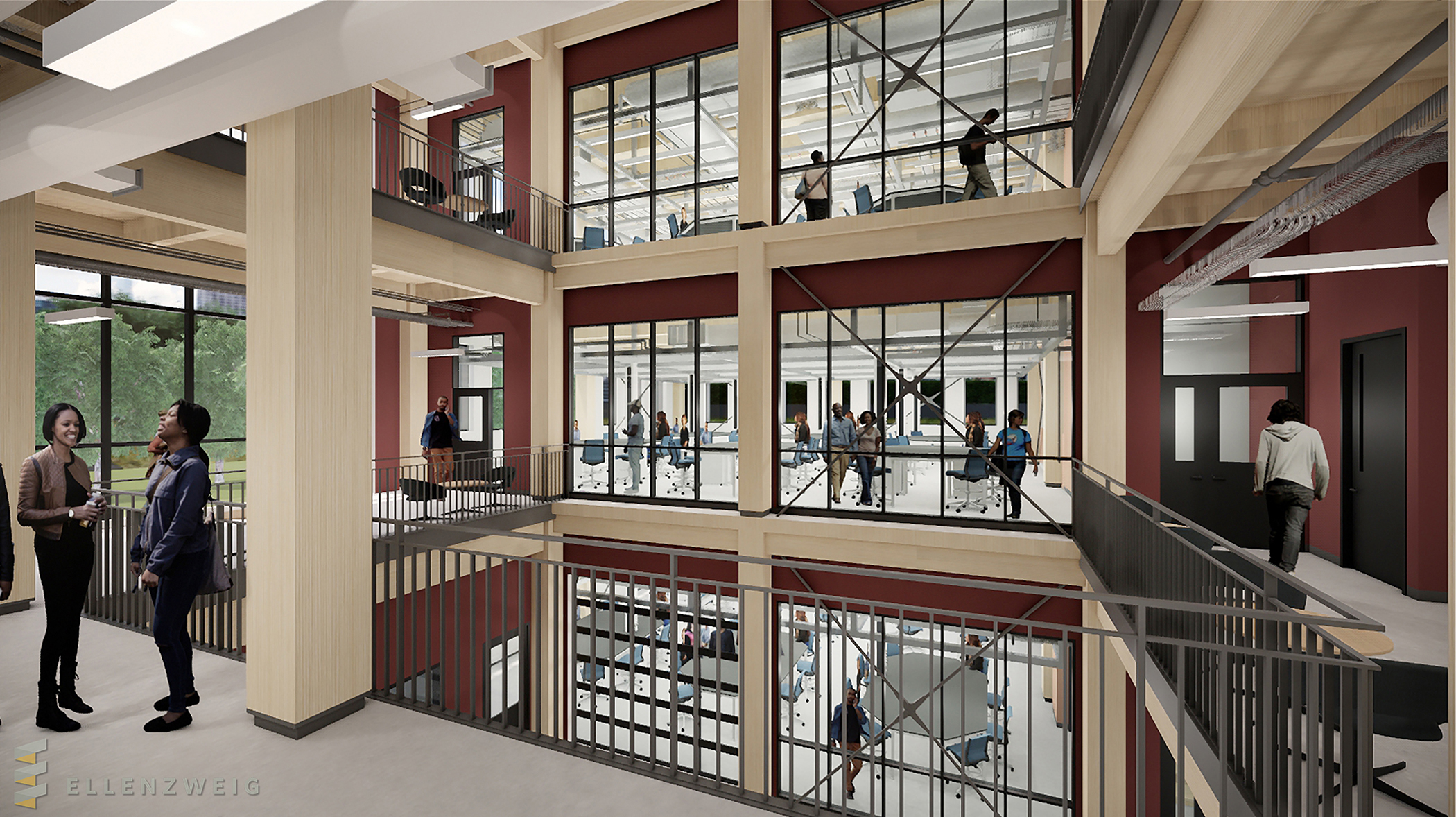
Michigan State University’s future STEM Teaching and Learning Facility will be the first building in the state of Michigan to use mass timber instead of concrete and steel for its load-bearing structure. The $100 million facility will be constructed of glue laminated wooden columns and cross laminated timber (CLT) floors and ceilings.
Among mass timber’s many benefits, the university was drawn in particular to the quicker construction time and related cost-efficiencies afforded by CLT, and the pleasing aesthetics of exposed wood, which promises to create a warm, inviting environment for learning for years to come.
Many analysts and observers believe that Michigan State’s building will catalyze additional mass timber construction throughout the state of Michigan and potentially lead to the establishment of CLT manufacturing in the state, long known for its forest resources.
Everything Old is New Again
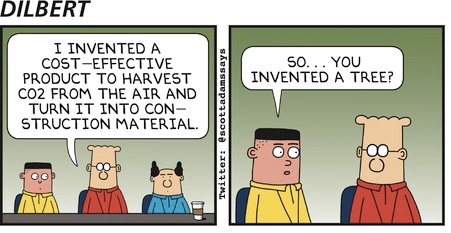
Dilbert, the comic strip written and illustrated by Scott Adams, recently reiterated what we all know—there is no substitute for wood when it comes to a cost-effective, climate-smart material for building construction. Dilbert currently appears in over 2,000 newspapers and online sources in approximately 65 countries, thus providing important food for thought through satire, here in favor of the softwood lumber industry.
Insights on the Competition
Concrete Masonry Checkoff Program Launched to Promote Demand for Concrete
Congress passed the Concrete Masonry Products, Research, Education and Promotion Act on October 5, 2018, creating the opportunity for the Concrete Masonry (CMU) Checkoff Program.
The vision of the CMU Checkoff is to create the future path where concrete masonry is the product of choice, by more effectively generating and leveraging industry investments to support needed research, education, and promotion that generates more demand and more sales for concrete. This program pulls $0.01 from the sale of every concrete masonry unit made in the United States with the potential to annual generate $10 million to be used towards programming to drive product demand for concrete. To learn more about the CMU Checkoff, watch the video below or read the overview guide.
Industry Resources
FEA’s Housing Dashboard
These housing dashboards are provided compliments of Forest Economic Advisors (FEA):
View the March Dashboard
View the April Dashboard
Virginia Tech’s Monthly Housing Report
This monthly housing commentary report is a free service of Virginia Tech and is intended to help one gauge future business activity in the U.S. housing market.
Virginia Tech for February 2019 (released in April 2019)
Part A: February Housing Commentary
Part B: February Economic Conditions
A Closer Look – 2018: Another Year of Exponential Growth for the SLB and Softwood Lumber Industry
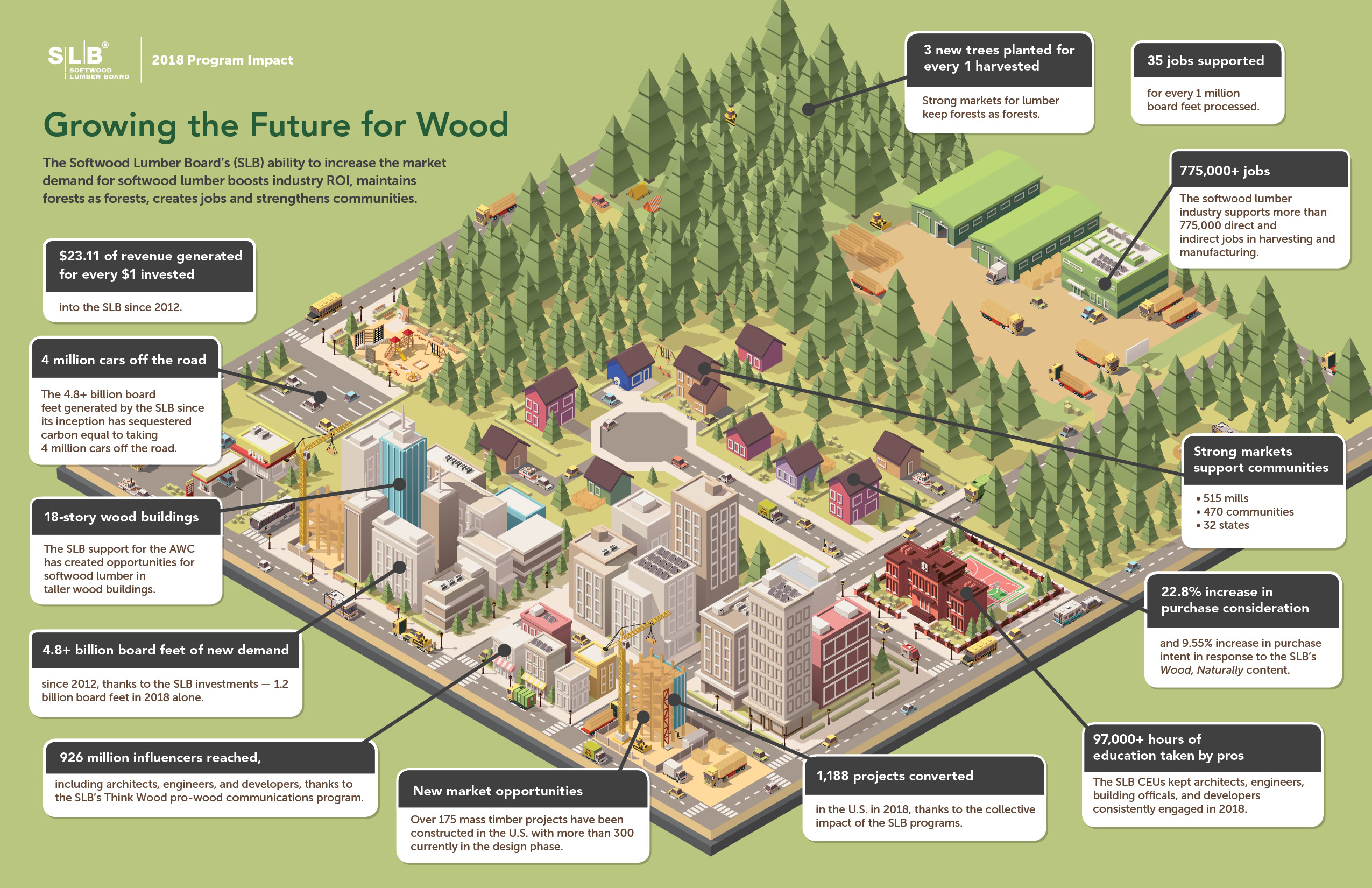
ach year, the SLB critically analyzes the results of its program investments from the previous year to quantify impact and return on investment. As in past years, the SLB delivered tremendous value-add and impact across its target markets and segments. Since its inception in 2012, the SLB has now generated $23.11 of revenue for every $1 invested and has created over 4.86 billion board feet of new demand, including 1.2 billion board feet in 2018 alone. This demand and the associated consumption of softwood lumber helped the industry to maintain over 775,000 jobs.
Other key outputs in 2018 included the following:
- The SLB’s support for the AWC created a game-changing opportunity for softwood lumber, with the building code community approving mass timber in buildings up to 18 stories tall.
- Led by WoodWorks, the SLB’s programs converted 1,188 projects to wood in place of competing materials.
- Wood, Naturally content led to a 22.8% increase in purchase consideration and a 9.55% increase in purchase intent.
- Think Wood’s pro-wood communications reached over 926 million architects, engineers, developers, and other influencers.
- Combined, the SLB’s programs delivered over 97,000 hours of high-quality, wood-focused continuing education to design and construction professionals.
How Forests Make Our Lives Better
#ForestProud’s latest video, How Forests Make Our Lives Better, reminds us of the many and diverse benefits that healthy forests give to people, ranging from environmental, recreational, and human health benefits to livelihood opportunities and raw materials to develop and shape the built environment.
The video calls on all of us to respect and value forests by ensuring that we create thriving markets for wood and wood products and invest in research and conservation to support healthy forest management and the maintenance of these important renewable resources. In looking after trees, we ultimately look after ourselves.
Visit #ForestProud to view the video and for more information.
Our Planet Debuts in April
World-renowned naturalist Sir David Attenborough echoed some of these sentiments in Netflix’s new Our Planet series, which debuted in early April. Attenborough emphasized the importance of sustainable forest management and the need to reinvigorate tree plantations as a way to recover degraded land, restore, and conserve forests, and provide enough wood to meet global demand.


